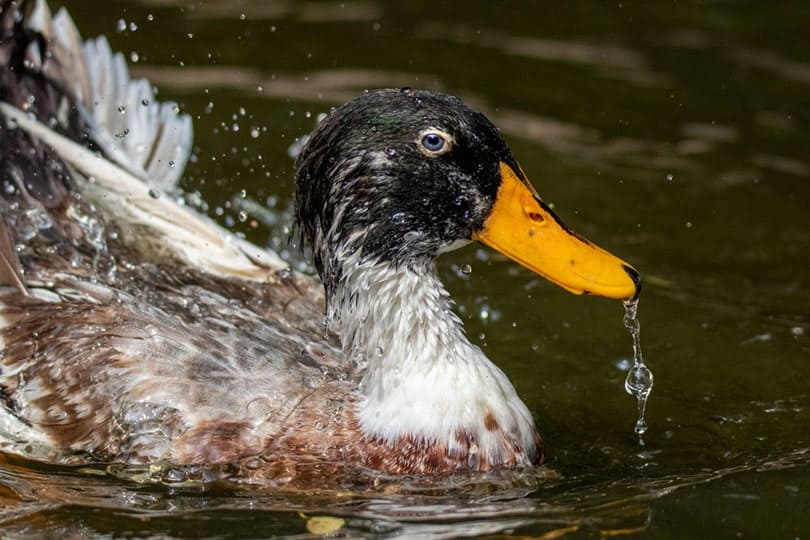Ducks are a common sight in many urban and suburban areas. However, few people know that ducks can easily be raised as a source of food. Ducks and duck farming are becoming more popular due to the health benefits they provide. Duck meat is high in protein and low in fat, making it a healthy option for those looking for a balanced meal. Additionally, duck feathers can be used for insulation and furniture, and their eggs can be used for cooking or eaten raw.
As a dual-purpose bird1, the Silver Appleyard Duck provides both a large amount of meat and an abundance of eggs. The Silver Appleyard duck can sometimes be hard to find, but it’s a popular meat and egg breed among hobbyists and commercial farmers alike. Read on to find out more about this special bird.

Quick Facts about the Silver Appleyard Duck
| Breed Name: | Silver Appleyard Duck |
| Place of Origin: | The United Kingdom |
| Uses: | Dual-purpose, meat, and eggs |
| Drake (Male) Weight: | Maximum of 9 lbs |
| Hen (Female) Size: | Maximum of 8 lbs |
| Drake Color: | Breast, flanks, and shoulders are chestnut red; silver wings and creamy-white undersides |
| Hen Color: | White with a variety of brown and gray markings |
| Lifespan: | 4 – 8 years |
| Climate Tolerance: | Cold tolerant, does well in most climates |
| Care Level: | Easy |
| Production: | Good for meat and eggs |
| Temperament: | Friendly, calm, and curious |
Silver Appleyard Duck Origins
Reginald Appleyard developed this big, colorful duck at his Priory Waterfowl Farm2 near Bury St. Edmund, England. As stated in a 1940s farm brochure, his aim was to breed a beautiful breed of duck with beauty, size, large white eggs, and a deep, wide breast. Silver Appleyards were introduced to the United States in the 1960s and became available to the general public in 1984. In 2000, the American Poultry Association accepted the breed for inclusion in the American Standard of Perfection.

Silver Appleyard Duck Characteristics
Silver Appleyards are a stocky breed with a compact body. The posture of these ducks is slightly erect, but not nearly as much as that of an Indian Runner duck. At first glance, a Silver Appleyard can be mistaken for a Mallard due to their similar plumage. This breed possesses two restricted but dominant genes. They both result in light pigmentation on the head and body. This can result in a silver-shaded appearance.
As with most domesticated duck breeds, this breed is unable to fly. It may be possible for a Silver Appleyard Duck to get off the ground and move a few inches, but that’s all they can do.
Uses
Silver Appleyard duck meat is lean. Compared to Pekin ducks, this breed produces less fat in its meat. Although duck fat is often preferred for cooking, people looking for a lean poultry meat prefer Silver Appleyards. This breed is prized by meat duck breeders and gourmet chefs for its large breasts and is also favored for its mild flavor and non-greasy texture of meat.
Once mature, Silver Appleyard ducks weigh 7 to 9 pounds and hens lay between 220 and 270 eggs a year. The eggs of the Silver Appleyard duck usually weigh between 3 and 4.4 ounces. This breed lays medium to large white eggs which hatch in roughly 26 to 29 days. The average male drake matures in approximately 9 weeks, whereas most females take a few extra weeks to reach slaughter weight. They are also kept as show birds.
Appearance & Varieties
The Silver Appleyard duck can also be categorized as a Large Appleyard duck or a Miniature Appleyard duck, depending on the breeding methods used to produce different types of the breed.
The head and neck of a mature drake are dark green. Its neck is ringed with silver to white. The chest area of a mature Silver Appleyard drake is a chestnut brown shade with silver flecks. Its tail is black and white. Drakes of this breed have a pale cream stomach and their wings and backs are brown or gray. Silver Appleyard drakes change color as they grow. Often, the head turns silver, and the chestnut plumage on the body darkens.
Silver Appleyard mature hens have brown to gray feathers on their crowns, backs, tails, and wings. They have silver to white heads and necks. As the hen ages, it becomes a darker shade on the belly and chest. Hens have orange beaks, while drakes have greenish-yellow beaks. When mature, both drakes and hens have orange legs. Ducklings of this breed are yellow with a black mohawk-style stripe on their crowns and a black tail.
Population, Distribution & Habitat
As these ducks are kept for meat, eggs, as a pet, or used for exhibition, you might expect the Silver Appleyard to be extremely popular, but their numbers are actually thought to be extremely low. They are found in North America and Europe, where they happily occupy farmyards and ponds, but their population is thought to be threatened. The Livestock Conservancy lists Silver Appleyard ducks as threatened. Rare Breeds Survival Trust protects the breed in the United Kingdom.

Are Silver Appleyard Ducks Good for Small-Scale Farming?
Small-scale farming is a type of agricultural production that focuses on the use of sustainable farming practices to produce food for local markets. While there are many types of ducks that can be raised for small-scale farming, Silver Appleyard ducks are a good choice because they are a heritage breed that is well suited for small farms. These ducks are hardy and easy to care for, and they can be used to produce high-quality eggs and meat.
See Also:
- 114 Duck Breeds: The Complete List (With Pictures)
- 11 Colorful and Beautiful Duck Breeds (with Pictures)
Featured Image Credit: umang sethia, Shutterstock
